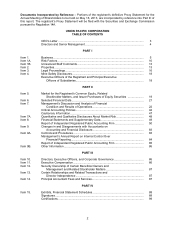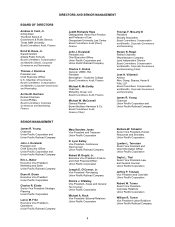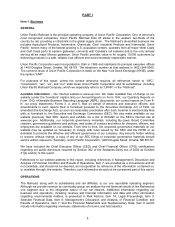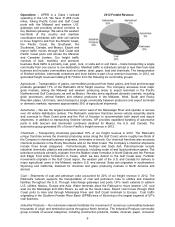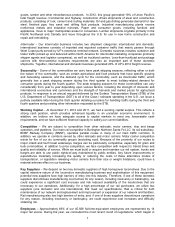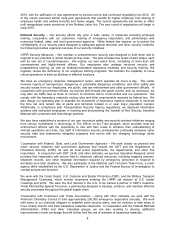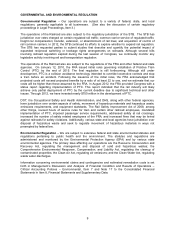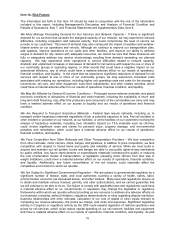Union Pacific 2012 Annual Report Download - page 6
Download and view the complete annual report
Please find page 6 of the 2012 Union Pacific annual report below. You can navigate through the pages in the report by either clicking on the pages listed below, or by using the keyword search tool below to find specific information within the annual report.
6
Operations – UPRR is a Class I railroad
operating in the U.S. We have 31,868 route
miles, linking Pacific Coast and Gulf Coast
ports with the Midwest and eastern U.S.
gateways and providing several corridors to
key Mexican gateways. We serve the western
two-thirds of the country and maintain
coordinated schedules with other rail carriers
to move freight to and from the Atlantic Coast,
the Pacific Coast, the Southeast, the
Southwest, Canada, and Mexico. Export and
import traffic moves through Gulf Coast and
Pacific Coast ports and across the Mexican
and Canadian borders. Our freight traffic
consists of bulk, manifest, and premium
business. Bulk traffic is primarily coal, grain, rock, or soda ash in unit trains – trains transporting a single
commodity from one source to one destination. Manifest traffic is individual carload or less than train-load
business and includes commodities such as lumber, steel, paper, food and chemicals. The transportation
of finished vehicles, intermodal containers and truck trailers is part of our premium business. In 2012, we
generated freight revenues totaling $19.7 billion from the following six commodity groups:
Agricultural – Transportation of grains, commodities produced from these grains, and food and beverage
products generated 17% of the Railroad’s 2012 freight revenue. The Company accesses most major
grain markets, linking the Midwest and western producing areas to export terminals in the Pacific
Northwest and Gulf Coast ports, as well as Mexico. We also serve significant domestic markets, including
grain processors, animal feeders and ethanol producers in the Midwest, West, South and Rocky
Mountain states. Unit trains, which transport a single commodity between producers and export terminals
or domestic markets, represent approximately 35% of agricultural shipments.
Automotive – We are the largest automotive carrier west of the Mississippi River and operate or access
over 40 vehicle distribution centers. The Railroad’s extensive franchise serves vehicle assembly plants
and connects to West Coast ports and the Port of Houston to accommodate both import and export
shipments. In addition to transporting finished vehicles, UP provides expedited handling of automotive
parts in both boxcars and intermodal containers destined for Mexico, the U.S. and Canada. The
automotive group generated 9% of Union Pacific’s freight revenue in 2012.
Chemicals – Transporting chemicals generated 16% of our freight revenue in 2012. The Railroad’s
unique franchise serves the chemical producing areas along the Gulf Coast, where roughly two-thirds of
the Company’s chemical business originates, terminates or travels. Our chemical franchise also accesses
chemical producers in the Rocky Mountains and on the West Coast. The Company’s chemical shipments
include three broad categories: Petrochemicals, Fertilizer and Soda Ash. Petrochemicals include
industrial chemicals, plastics and petroleum products, including crude oil and liquid petroleum gases. The
petroleum products primarily originate from the Bakken shale formation in North Dakota and the Permian
and Eagle Ford shale formations in Texas, which we also deliver to the Gulf Coast area. Fertilizer
movements originate in the Gulf Coast region, the western part of the U.S. and Canada for delivery to
major agricultural users in the Midwest, western U.S. and abroad. Soda ash originates in southwestern
Wyoming and California, destined for chemical and glass producing markets in North America and
abroad.
Coal – Shipments of coal and petroleum coke accounted for 20% of our freight revenue in 2012. The
Railroad’s network supports the transportation of coal and petroleum coke to utilities and industrial
facilities throughout the U.S. Through interchange gateways and ports, UP’s reach extends to eastern
U.S. utilities, Mexico, Europe and Asia. Water terminals allow the Railroad to move western U.S. coal
east via the Mississippi and Ohio Rivers, as well as the Great Lakes. Export coal moves through West
Coast ports to Asia and through Mississippi River and Gulf Coast terminals to Europe. Coal traffic
originating in the Southern Powder River Basin (SPRB) area of Wyoming is the largest segment of UP’s
coal business.
Industrial Products – Our extensive network facilitates the movement of numerous commodities between
thousands of origin and destination points throughout North America. The Industrial Products commodity
group consists of several categories, including construction products, metals, minerals, paper, consumer
2012 Freight Revenue


